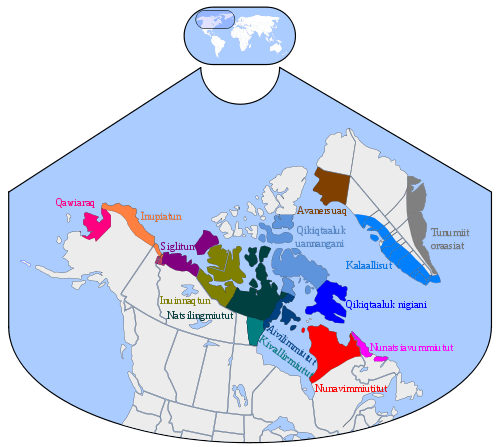Inuttitut
| Inuttitut | |
|---|---|
| Labrador Inuktitut | |
| Native to | Canada |
| Language codes | |
| ISO 639-3 | – |
| Glottolog |
labr1244[1] |
 Inuit dialects. Nunatsiavummiut is the pink ( ) in the east. | |
Inuttitut,[2] or Inuttut[3] is a Canadian dialect of Inuktitut. It is spoken across northern Labrador by Inuit people, whose traditional lands are known as Nunatsiavut.
The language has a distinct writing system, created by German missionaries from the Moravian Church in Greenland in the 1760s. This separate writing tradition, the remoteness of Nunatsiavut from other Inuit communities, and its unique history of cultural contacts have made it into a distinct dialect with a separate literary tradition.
It shares features, including Schneider's Law, the reduction of alternate sequences of consonant clusters by simplification, with some Inuit dialects spoken in Quebec. It is differentiated by the tendency to neutralize velars and uvulars, i.e. /g/ ~ /r/, and /k/ ~ /q/ in word final and pre-consonantal positions, as well as by the assimilation of consonants in clusters, compared to other dialects. Morphological systems (~juk/~vuk) and syntactic patterns (e.g. the ergative) have similarly diverged. Nor are the Labrador dialects uniform: there are separate variants traceable to a number of regions, e.g. Rigolet, Nain, Hebron, etc.
Although Nunatsiavut claims over 4,000 inhabitants of Inuit descent, only 550 reported any Inuit language to be their mother tongue in the 2001 census, mostly in the town of Nain. Inuttitut is seriously endangered.
Alphabet
Nunatsiavut uses a Latin alphabet devised by German-speaking Moravian missionaries, which includes the letter ĸ (kra, often also written with an uppercase K). In 1980, the Labrador Inuit Standardized Writing System was developed during a meeting with elders and educators to provide consistency and clarity.[4] The previous orthography used ⟨o⟩ to represent /u/ before uvulars, however the Labrador Inuttitut no longer has a distinct /q/ at the end of syllables. In the new orthography, o represents /uu/.[5]
| Capital letters | ||||||||||||||||||||
| Â | A | E | F | G | H | I | J | K | Κ' | L | M | N | O | P | R | S | T | U | V | W |
| Lower case letters | ||||||||||||||||||||
| â | a | e | f | g | h | i | j | k | ĸ | l | m | n | o | p | r | s | t | u | v | w |
The main difference with the Latin orthography used for other Inuktitut dialects are the following letters:[5]
- /aː/ â = aa
- /iː/ e = ii
- /uː/ o = uu
- /χ/ ĸ = q
- /ŋŋ/ ng, n̲g̲ or ngng = nng
Dialects
At one time, there existed two dialects of the Inuttut language. The Inuit that reside south of the Davis Inlet in what is now known as Nunatuĸavut once spoke a divergent dialect known as "Nunatuĸavummiutut", indicated by differences in toponymy.[6] However, due to heavy European immigration into Nunatuĸavut, this dialect has since become extinct.[6]
The Nunatsiavummiut dialect has survived due to the isolation of the Inuit who reside north of the Davis inlet. There exist two sub-dialects of Inuttitut, the northern dialect (spoken mainly in Nain) and the southern dialect (spoken only by a few elders in Rigolet).[7] They differ only in phonology.
Vocabulary comparison
The comparison of some animal names in the two dialects of Inuktitut:
| Inuktitut[8] | Inuttitut[9] | meaning |
| siksik ᓯᒃᓯᒃ | sitsik | ground squirrel |
| qugjuk ᖃᒡᔪᒃ | ĸutjuk | tundra swan |
| aarluk ᐋᕐᓗᒃ | âlluk | killer whale |
| amaruq ᐊᒪᕈᖅ | amaguk | gray wolf |
| isunngaq ᐃᓱᙵᖅ | isungak | pomarine jaeger |
| kanguq ᑲᖑᖅ | kangak | snow goose |
| tuktu ᑐᒃᑐ | tuttuk | caribou |
| tiriganniaq ᑎᕆᒐᓐᓂᐊᖅ | tigiganniak | arctic fox |
| umingmak ᐅᒥᖕᒪᒃ | umimmak | muskox |
German loanwords
The German loanwords[9] used in Inuttitut date from the period of the German missionaries of Moravian Church (1760s).
- ailvat (< Ger. elf) 'eleven'
- ainsik (< Ger. eins) 'one o'clock'
- fiarâ (< Ger. vier) 'four o'clock'
- Fraitâg ( < Ger. Freitag) 'Friday'
- kâttopalak (< Ger. Kartoffel) 'potato'
- Metvog (< Ger. Mittwoch) 'Wednesday'
- Montâg (< Ger. Montag) 'Monday'
- naina (< Ger. neun) 'nine'
- sâksit (< Ger. sechs) 'six'
- senat (< Ger. zehn) 'ten'
- sepat (< Ger. sieben) 'seven'
- silipa (< Ger. Silber) 'coin'
- situnati (< Ger. Stunde) 'hour'
- Sontâg (< Ger. Sonntag) 'Sunday'
- Sunâpint (< Ger. Sonnabend) 'Saturday'
- suvai (< Ger. zwei) 'two'
- suvailva (< Ger. zwölf) 'twelve'
- tarai (< Ger. drei) 'three'
- taraitijik (< Ger. dreißig) '30 odd 30 rifle and ammunition'
- Tenistâg (< Ger. Dienstag) 'Tuesday'
- Tonistâg (< Ger. Donnerstag) 'Thursday'
- viaga (< Ger. vier) 'four'
- vogik (< Ger. Woche) 'week'
References
- ↑ Hammarström, Harald; Forkel, Robert; Haspelmath, Martin, eds. (2017). "Labrador Eskimo". Glottolog 3.0. Jena, Germany: Max Planck Institute for the Science of Human History.
- ↑ Labrador Inuit
- ↑ Labrador Inuttut Dictionary
- ↑ "Inuttitut (Labrador)". Canadian Bible Society.
- 1 2 Andersen, Catharyn; Johns, Alana (2005). "Labrador Inuttitut: Speaking into the future". Études/Inuit/Studies. 29 (1–2). pp. 187–205.
- 1 2 "Unveiling NunatuKavut". Canadian Environmental Assessment Agency, 2010. Web. Accessed January 26th 2012.
- ↑ http://www.languagegeek.com/inu/inuktitut.html
- ↑ Inuktitut Living Dictionary
- 1 2 http://www.labradorvirtualmuseum.ca/english-inuttut.htm
Further reading
- Smith, L. R., and Sam Metcalfe. Labrador Inuttut – English Glossary. [St. John's]: Memorial University of Newfoundland, 1970.